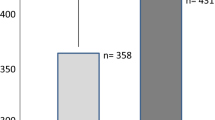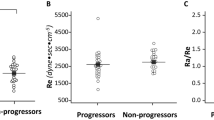Abstract
Objective: This study aimed to assess the blood pressure-lowering potency, renoprotective efficacy and safety of the angiotensin II type 1 (AT1)-receptor blocker irbesartan in monotherapy or in combination with hydrochlorothiazide or other antihypertensive medications in patients with type 2 diabetes mellitus switched from various antihypertensive pretreatments.
Design and methods: Multicentre, open, prospective, 6-month observational study in 38 016 patients at 9838 general practitioners’ offices throughout Germany. Microalbuminuria in type 2 diabetics was measured with semiquantitative immunological Micral-II urine dipstick tests.
Main outcome measure: Proportion of patients with albuminuria at baseline and at 3 and 6 months. Analysis of adverse events.
Results: The study population consisted of an equal number of males and females, mean body mass index was 28.4 kg/m2, and mean glycosylated haemoglobin (HbA1c) was 7.2%. After the switch to irbesartan (in 86% of patients to the 300mg dosage in mono-or combination therapy), mean systolic/diastolic blood pressure was decreased by 23/12mm Hg. Irbesartan treatment over 6 months reduced the proportion of patients with microalbuminuria from 49.2 to 23.2% (relative reduction: 52.8%; p < 0.05) and the rate of patients with macroalbuminuria from 6.0 to 4.4% (relative reduction: 26.7%; p < 0.05). The renoprotective effect of irbesartan was consistent in various subgroups (analyses by sex, weight, diabetes duration, insulin treatment, strength of blood pressure-lowering effect, and antihypertensive pretreatment). Tolerability was excellent: 99.6% of patients remained free of any adverse events during the study.
Conclusion: The profound blood pressure-lowering and renoprotective effect of irbesartan in type 2 diabetes documented in clinical endpoint studies was confirmed in second-line therapy in a large sample of primary-care patients. Furthermore, in patients switched from previous ACE-inhibitor therapy, the renoprotective effect of irbesartan was of the same magnitude as in the total cohort.




Similar content being viewed by others
Notes
The use of trade names is for product identification purposes only and does not imply endorsement.
References
Stamler J, Vaccaro O, Neaton JD, et al. Diabetes, other risk factors, and 12-yr cardiovascular mortality for men screened in the multiple risk factor intervention trial. Diabetes Care 1993; 16: 434–44
Haffner SM, Lehto S, Ronnemaa T, et al. Mortality from coronary heart disease in subjects with type 2 diabetes and in nondiabetic subjects with and without prior myocardial infarction. N Engl J Med 1998; 339: 229–34
Ritz E. Albuminuria and vascular damage: the vicious twins. N Engl J Med 2003; 348: 2349–52
American Diabetes Association. Diabetic nephropathy. Diabetes Care 2002; 25: 85–9
Hillege H, Janssen W, Bak A, et al. Microalbuminuria is common, also in a nondiabetic, nonhypertensive population, and an independent indicator of cardiovascular risk factors and cardiovascular morbidity. J Intern Med 2001; 249: 519–26
Gerstein HC, Mann JFE, Yi Q, et al. Albuminuria and risk of cardiovascular events, death, and heart failure in diabetic and nondiabetic individuals. JAMA 2001; 286: 421–6
Stehouwer C, Nauta J, Zeldenrust G, et al. Urinary albumin excretion, cardiovascular disease, and endothelial dysfunction in non-insulin-dependent diabetes mellitus. Lancet 1992; 340: 319–23
Beatty O, Ritchie C, Bell P, et al. Microalbuminuria as identified by a spot morning urine specimen in non-insulin-treated diabetes: an eight-year follow-up study. Diabet Med 1995; 12: 261–6
Damsgaard E, Froland A, Jorgensen O, et al. Prognostic value of urinary albumin excretion rate and other risk factors in elderly diabetic patients and non-diabetic control subjects surviving the first 5 years after assessment. Diabetologia 1993; 36: 1030–6
MacLeod J, Lutale J, Marshall S. Albumin excretion and vascular deaths in NIDDM. Diabetologia 1995; 38: 610–6
American Diabetes Association. Position statement on “diabetic nephropathy”: position statement. Diabetes Care 2004; 27Suppl. 1: S79–83
Hasslacher C. Diabetische Nephropathie in “Praxis-Leitlinien der Deutschen Diabetes Gesellschaft”. Diabetes und Stoffwechsel 2002; 11 Suppl. 2: 17–9
Parving HH, Lehnert H, Brochner-Mortensen J, et al. The effect of irbesartan on the development of diabetic nephropathy in patients with type 2 diabetes. N Engl J Med 2001; 345: 870–8
Lewis EJ, Hunsicker LG, Clarke WR, et al. Renoprotective effect of the angiotensin-receptor antagonist irbesartan in patients with nephropathy due to type 2 diabetes. N Engl J Med 2001; 345: 851–60
Brenner BM, Cooper ME, de Zeeuw D, et al. Effects of losartan on renal and cardiovascular outcomes in patients with type 2 diabetes and nephropathy. N Engl J Med 2001; 345: 861–9
Fernandez I, Paez Pinto J, Hermosin Bono T, et al. Rapid screening test evaluation for microalbuminuria in diabetes mellitus. Acta Diabetol 1998; 35: 199–202
Piehlmeier W, Renner R, Schramm W, et al. Screening of diabetic patients for microalbuminuria in primary care: The PROSIT-Project. Proteinuria Screening and Intervention. Exp Clin Endocrinol Diabetes 1999; 107: 244–51
SAS. Cary NC: SAS Institute Inc., 1999
Guidelines committee. European Society of Hypertension-European Society of Cardiology guidelines for the management of arterial hypertension. J Hypertens 2003; 21: 1011–53
Chobanian AV, Bakris GL, Black HR, et al. The seventh report of the Joint National Committee on Prevention, Detection, Evaluation, and Treatment of High Blood Pressure: The JNC 7 Report. JAMA 2003; 289: 2560–72
Brueckel J, Koebberling J. Definition, Klassifikation und Diagnostik des Diabetes mellitus. In “Praxis-Leitlinien der Deutschen Diabetes Gesellschaft” Diabetes und Stoffwechsel 2002; 11Suppl. 2: 6–8
Zelmanovitz T, Gross J, Oliveira J, et al. The receiver operating characteristics curve in the evaluation of a random urine specimen as a screening test for diabetic nephropathy. Diabetes Care 1997; 20: 516–9
Lum G. How effective are screening tests for microalbuminuria in random urine specimens? Ann Clin Lab Sci 2000; 30: 406–11
Vestbo E, Damsgaard E, Froland A, et al. Urinary albumin excretion in a population based cohort. Diabet Med 1995; 12: 488–93
Concato J, Shah N, Horwitz RI. Randomized, controlled trials, observational studies, and the hierarchy of research designs. N Engl J Med 2000; 342: 1887–92
Lewis EJ, Hunsicker LG, Bain RP, et al. The effect of angiotensin-converting-enzyme inhibition on diabetic nephropathy. N Engl J Med 1993; 329: 1456–62
ACE Inhibitors in Diabetic Nephropathy Trialist Group. Should all patients with type 1 diabetes mellitus and microalbuminuria receive angiotensin-converting enzyme inhibitors? A meta-analysis of individual patient data. Ann Intern Med 2001; 134: 370–9
Taal M, Brenner B. Renoprotective benefits of RAS inhibition: from ACEI to angiotensin II antagonists. Kidney Int 2000; 57: 1803–17
Law MR, Wald NJ, Morris JK, et al. Value of low dose combination treatment with blood pressure lowering drugs: analysis of 354 randomised trials. BMJ 2003; 326: 1427–31
The ALLHAT Officers and Coordinators for the ALLHAT Collaborative Research Group. Major outcomes in high-risk hypertensive patients randomized to angiotensin-converting enzyme inhibitor or calcium channel blocker vs diuretic: the Antihypertensive and Lipid-Lowering Treatment to Prevent Heart Attack Trial (ALLHAT). JAMA 2002; 288: 2981–97
Myers MG. Compliance in hypertension: why don’t patients take their pills? CMAJ 1999; 160: 64–5
Hasford J, Mimran A, Simons W. A population-based European cohort study of persistence in newly diagnosed hypertensive patients. J Hum Hypertens 2002; 16: 569–75
Bakris GL, Weir MR, Shanifar S, et al. Effects of blood pressure level on progression of diabetic nephropathy: results from the RENAAL study. Arch Intern Med 2003; 163: 1555–65
UK Prospective Diabetes Study Group. Tight blood pressure control and risk of macrovascular and microvascular complications in type 2 diabetes: UKPDS 38. BMJ 1998; 317: 703–13
Guidelines Committee. European Society of Hypertension-European Society of Cardiology guidelines for the management of arterial hypertension. J Hypertens 2003; 21: 1011–53
Hansson L, Zanchetti A, Carruthers S, et al. Effects of intensive blood-pressure lowering and low-dose aspirin in patients with hypertension: principal results of the Hypertension Optimal Treatment (HOT) randomised trial. HOT Study Group. Lancet 1998; 351: 1755–62
Schulte K, Fischer M, Meyer-Sabellak W. Efficacy and toler-ability of candesartan cilexetil monotherapy or in combination with other antihypertensive drugs: results of the AURA study. Clin Drug Invest 1999; 18: 453–60
Scholze J, Probst G, Bertsch K. Valsartan alone and in combination with hydrochlorothiazide in general practice: results from two postmarketing surveillance studies involving 54 928 patients with essential hypertension. Clin Drug Invest 2000; 20: 1–7
Bramlage P, Wittchen H, Pittrow D, et al. Mikroalbuminurie als früher Marker für eine erhöhte Morbidität und Mortalität. Fortschr Med Orig 2003; 121Suppl. I: 28–32
Acknowledgements
This study was supported by Sanofi-Synthelabo Berlin, Germany. We thank the investigators for their commitment to the study. The statistical analysis was performed by Dr Schauerte GmbH, Munich, Germany. PB is also an employee of Sanofi-Synthelabo Germany. The other authors have reported no conflicts of interest directly relevant to the content of this study.
Author information
Authors and Affiliations
Corresponding author
Rights and permissions
About this article
Cite this article
Lehnert, H., Bramlage, P., Pittrow, D. et al. Regression of Microalbuminuria in Type 2 Diabetics after Switch to Irbesartan Treatment. Clin. Drug Investig. 24, 217–225 (2004). https://doi.org/10.2165/00044011-200424040-00003
Published:
Issue Date:
DOI: https://doi.org/10.2165/00044011-200424040-00003




